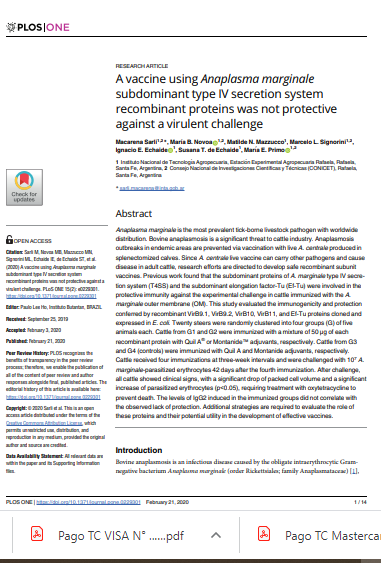Ver ítem
- xmlui.general.dspace_homeCentros Regionales y EEAsCentro Regional Santa FeEEA RafaelaArtículos científicosxmlui.ArtifactBrowser.ItemViewer.trail
- Inicio
- Centros Regionales y EEAs
- Centro Regional Santa Fe
- EEA Rafaela
- Artículos científicos
- Ver ítem
A vaccine using Anaplasma marginale subdominant type IV secretion system recombinant proteins was not protective against a virulent challenge
Resumen
Anaplasma marginale is the most prevalent tick-borne livestock pathogen with worldwide distribution. Bovine anaplasmosis is a significant threat to cattle industry. Anaplasmosis outbreaks in endemic areas are prevented via vaccination with live A. centrale produced in splenectomized calves. Since A. centrale live vaccine can carry other pathogens and cause disease in adult cattle, research efforts are directed to develop safe recombinant subunit vaccines.
[ver mas...]
Anaplasma marginale is the most prevalent tick-borne livestock pathogen with worldwide distribution. Bovine anaplasmosis is a significant threat to cattle industry. Anaplasmosis outbreaks in endemic areas are prevented via vaccination with live A. centrale produced in splenectomized calves. Since A. centrale live vaccine can carry other pathogens and cause disease in adult cattle, research efforts are directed to develop safe recombinant subunit vaccines. Previous work found that the subdominant proteins of A. marginale type IV secretion system (T4SS) and the subdominant elongation factor-Tu (Ef-Tu) were involved in the protective immunity against the experimental challenge in cattle immunized with the A. marginale outer membrane (OM). This study evaluated the immunogenicity and protection conferred by recombinant VirB9.1, VirB9.2, VirB10, VirB11, and Ef-Tu proteins cloned and expressed in E. coli. Twenty steers were randomly clustered into four groups (G) of five animals each. Cattle from G1 and G2 were immunized with a mixture of 50 μg of each recombinant protein with Quil A® or Montanide™ adjuvants, respectively. Cattle from G3 and G4 (controls) were immunized with Quil A and Montanide adjuvants, respectively. Cattle received four immunizations at three-week intervals and were challenged with 107 A. marginale-parasitized erythrocytes 42 days after the fourth immunization. After challenge, all cattle showed clinical signs, with a significant drop of packed cell volume and a significant increase of parasitized erythrocytes (p<0.05), requiring treatment with oxytetracycline to prevent death. The levels of IgG2 induced in the immunized groups did not correlate with the observed lack of protection. Additional strategies are required to evaluate the role of these proteins and their potential utility in the development of effective vaccines.
[Cerrar]

Autor
Fuente
PLoS One 15 (2) : e0229301. (2020 Feb 21)
Fecha
2020-02
Editorial
PLOS; National Center for Biotechnology Information
ISSN
1932-6203
Formato
pdf
Tipo de documento
artículo
Palabras Claves
Derechos de acceso
Abierto
 Excepto donde se diga explicitamente, este item se publica bajo la siguiente descripción: Creative Commons Attribution-NonCommercial-ShareAlike 2.5 Unported (CC BY-NC-SA 2.5)
Excepto donde se diga explicitamente, este item se publica bajo la siguiente descripción: Creative Commons Attribution-NonCommercial-ShareAlike 2.5 Unported (CC BY-NC-SA 2.5)


